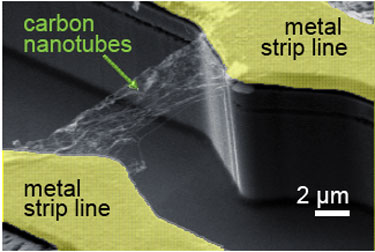
Scientists led by Professor Alexander Holleitner, physicist at the Technische Universität Muenchen (TUM), have found a way to directly measure the time during which photo-excited electrons flow in nanoscale photodetectors (“Time-Resolved Picosecond Photocurrents in Contacted Carbon Nanotubes“).
In solar cells and photodetectors, an optical radiation excites electrons to higher energy states thereby a photocurrent begins to flow. They could resolve the photocurrents on a picosecond time-scale which is about one-hundred times faster than is possible by conventional methods (a picosecond is one part in a billion of a millisecond). Most importantly, that is the time-scale at which electrons propagate in nanoscale photodetectors.
The reported method employs stripline circuits with a THz-band width, which are read-out by an ultrafast pump-probe laser spectroscopy. The researchers demonstrated the technique on carbon nanotubes with a diameter of only a nanometer (one millionth of a millimeter), which were electronically contacted by metal strip lines. The results allowed the researchers to directly measure the speed of photo-excited electrons which is about 375 times slower than the speed of light.
The insights and analytic opportunities made possible by the presented technique are relevant to a whole range of applications. These include, most notably, the further development of optoelectronic components such as nanoscale photodetectors, photoswitches, and solar cells.
The studies were funded by the Cluster of Excellence Nanosystems Initiative Munich (NIM) of the Deutsche Forschungsgemeinschaft, the Center for NanoScience (CeNS), and LMUexcellent.



